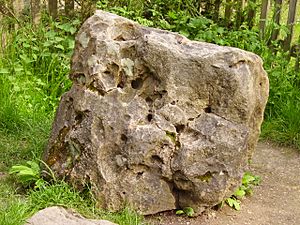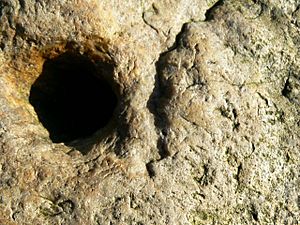Blowing Stone facts for kids
The Blowing Stone is a very old, special rock found in a village called Kingston Lisle in Oxfordshire, England. It's a type of hard sandstone known as a sarsen stone. This stone has holes in it, almost like a giant whistle! You can find it in a garden at the bottom of Blowingstone Hill. It's not far from the ancient Icknield Way path, and about 4.5 miles west of Wantage. It's also close to White Horse Hill, which is famous for its huge chalk horse carved into the hillside.
Blowingstone Hill is part of the Berkshire Downs, which is a long line of hills. At the very top of these hills is another ancient path called The Ridgeway.
What Makes the Blowing Stone Special?
This stone is famous because it can make a loud, booming sound! If someone knows how to blow into one of its holes in just the right way, it creates a deep noise. It's a bit like playing a giant, ancient instrument.
The Legend of King Alfred
According to an old story, the sound from the Blowing Stone could be heard all the way up on White Horse Hill. In the 1800s, people who studied old things (called antiquarians) believed that King Alfred the Great and his Saxon soldiers might have camped on White Horse Hill. The legend says that King Alfred used the Blowing Stone to call his troops together for the Battle of Ashdown in the year 871 AD. In this important battle, Alfred and his army fought against the Danes.
The Blowing Stone in Books
The Blowing Stone has even appeared in famous books!
- In Thomas Hughes' well-known novel, Tom Brown's School Days, the stone is mentioned as the Blawing Stwun. The village where it's located is called Kingstone Lisle in the book.
- It's also one of the "sacred stones" in William Horwood's fantasy book, Duncton Wood. This book is the first in a series about a group of moles.



